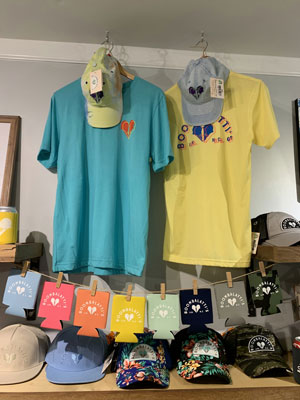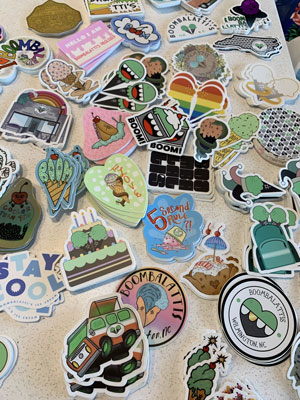6/1/2022
Make Room for Merch
Katie Elzer-Peters

Merch: (noun) “An informal word for merchandise, especially items related to a band, movie, sports team, etc.”
When Wes Bechtel and his wife purchased Boombalatti’s Ice Cream in Wilmington, North Carolina, near Wrightsville Beach, merch was on his mind.
He remembered, “We used to take family vacations to the Outer Banks every year and one of my uncles would buy a t-shirt at every bar or restaurant we visited. Every. Single. One.”
I resemble that comment. (Glances down at my Groovy Plants Ranch t-shirt, which I changed into from my Rockledge Gardens “We’re Rooting for You” t-shirt that I sleep in every night. When I’m cold, I don my eggplant colored hoodie from The Mustard Seed Landscaping and Garden Center in Blowing Rock, North Carolina.)
Wes knew he could offer something more than a great dip of ice cream to tourists and locals. (FYI—I think Boombalatti’s could be the next Jeni’s. Great product + great branding . . . you do the math.) The resulting Boombalatti’s shirts and hats have taken on a life of their own, as has their artist series sticker collection. If an ice cream store can do it, so can you.
Pictured: Boombalatti’s Ice Cream in Wilmington, North Carolina, has merchandising down, offering a variety of items customers can buy to take home a lasting piece of their favorite locally owned shop.

Shirts Aren’t Just Shirts
It would be so easy to drop into a rabbit hole and spend the next 1,000 words discussing human psychology. After all, someone who buys a t-shirt at a concert or from an ice cream shop absolutely has other t-shirts to wear. They’re not buying a shirt because it’s an article of apparel. They’re buying:
• A memento of a memorable experience
• A cultural signifier of affiliation, exclusivity
• A sense of belonging and community identification
When you look at it that way, merch makes much more sense.
Where Merch Works
You’d be surprised. Any business that’s established a loyal following can sell merch. Think about it. We’re all stuck behind screens. When we emerge, blinking, into the light, we need to be able to easily identify members of our community in real life. (My Harry Styles “Love on Tour” tote bag sees and acknowledges your Harry Styles “Treat People with Kindness” T-shirt.)
Benjamin Futa, owner of BOTANY, a plant shop in South Bend, Indiana, that started as a pop-up during the spring of 2021 has been working to develop BOTANY-branded products, but was inspired to move beyond creating branded products and into creating merch after customers told him that they’d rather buy shirts with his logo than the other trendy shirts he stocked.
If your business:
• has been a fixture of your community for years,
• is new, but has an active and engaged Instagram following,
• if you want to do a charity fundraiser,
• if your store is a place people visit each year on a family vacation,
• if people bring their friends and family to visit your shop,
or
• if you have identifiable landmarks, pets, murals or plants at your shop …
… you’re a candidate for a successful merch program. Here’s how to create and manage one.
Start with Staples
“You’ll need a classic one-color printed t-shirt design that’s available year-round in a variety of sizes,” Wes says.
He recommends springing for the more comfortable soft knits. Bella Canvas and Next Level are two good soft styles. They might cost a little more, but you’ll sell more and the shirts will get worn more, especially by younger people. (The youths aren’t into scratchy, heavy cotton shirts.)
Hats are a good next item and coozies are inexpensive, branded merch useful for tossing in with a gift card for fundraising donations. Wes cautions staying away from anything too niche. “It took us years to go through one order of socks.
Watch Trends
Tap into the cultural zeitgeist with designs. Neon and neon-esque signs are making a comeback. Boombalatti’s popular lineup from last year piggybacked on the trend and it’s been immensely successful.
“Have kids? Let them pick the colors,” Wes says. “The 19-year-olds that work in the shops told me to buy mustard-colored shirts. I thought they were nuts. We sold them all.”
It’s a lesson we often hear repeated: you are not your customer.
Work with Local Makers & Creatives
Odds are good that you have a screen printing company nearby. If you do, use them to print your merchandise and then tell your customers they were printed down the street. The COVID pandemic amplified and accelerated “buy local” movements, as consumers rushed to help neighborhood businesses. It caused a surge in start-up small businesses, which Benjamin remarked upon. “There’s this whole cohort of businesses that began as pop-ups as people got laid off and are growing into permanent establishments.”
Those small businesses—pottery makers, apparel designers, curators of vintage glassware, handbag designers—A) are a rich source of creativity for design collaboration; B) a potential source for limited edition merchandise; and C) often have their own followings that will flock to your establishment if you work with them.
For a long time, our industry has focused heavily on price. The tide has turned. Younger consumers are less focused on price than they are on provenance. Locally made, limited editions will now sell out while mass-produced sits on shelves. That’s another reason why merch is handy. By definition, it can only be purchased from you. (My favorite pencil store used to offer one clickable ballpoint pen that could only be purchased in-store, not online. Needless to say, just about every single visitor bought one.)
Incorporate a Community Component
Boombalatti’s kicked their artist series sticker program into high gear during 2020.
“It was such a difficult year. We asked ourselves, ‘What can we do to put positivity into the world?’” Wes says. “We figured that local artists were probably having a rough time, too. We paid them per design and gave a donation to the charity of their choice. I asked 13 people to design and 12 said yes.”
Each month they release a new set of three stickers, and their customers and fans of the artists come by to collect.
Benjamin has invited the community in for their first round of t-shirt designs, inviting artists to submit designs and their followers to vote and select three finalists for printing.
“We’ll print one round of the three date-stamped winners, and when they’re gone, they’re gone,” he says. They could have designed their own shirts, but community is woven into the mission of the entire business. “Involving community takes more time and effort, but then people are more invested in the project.”
Plan Merch Drops
Speaking of dates, it’s important to keep merch fresh. Beyond stocking staples, release a yearly design or small collection of designs to entice people to purchase repeatedly. Make the unveiling a little event online with a giveaway for social shares. Wes recommends that once you’re down to odds and ends, post “shop my closet” stories on social media and let people buy the leftovers.
Get Physical
Most merch is a form of apparel, so people have to be able to touch the shirts, hold them up and/or try them on.
“I learned this the hard way,” Wes says. “I had merch displayed on shelves behind the counter, but it was too much work for people to ask for it to try on.”
If merch isn’t your core business, you also might not want to take time to bring out multiple sizes for people.
Wes says, “You’re gonna lose five shirts a year and you’ll sell 10 times as many. When I brought them out from behind the counter, I sold more shirts in February than on Black Friday weekend.”
That’s another common retail reminder: reduce friction surrounding the purchase, whether it’s merch or something else.
Garden-related activities are creative, artistic and community-related by nature. Merch is just an extension of that. GP
Katie Elzer-Peters is the owner of The Garden of Words, LLC, a green-industry digital marketing agency. Contact her at Katie@thegardenofwords.com.